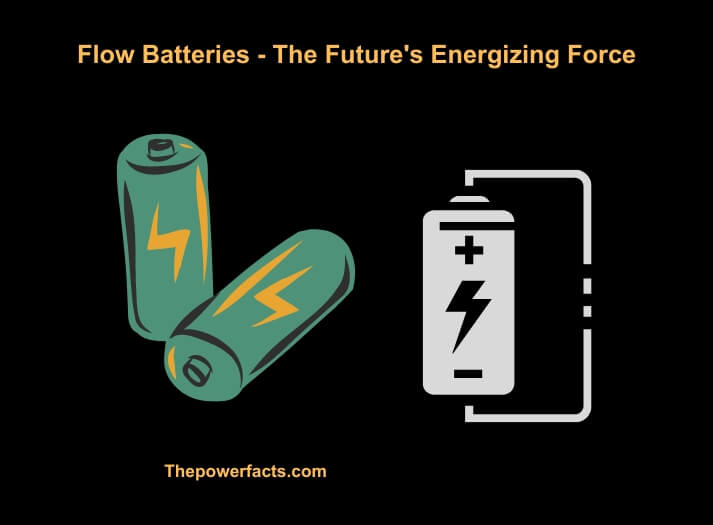Ever heard the saying, “You can’t have your cake and eat it too?” Well, when it comes to energy storage, flow batteries are proving that old adage wrong. These novel devices are giving traditional battery systems a run for their money, offering a more sustainable, efficient, and longer-lasting solution. But what exactly are flow batteries, and what makes them so special? Buckle up, as we take you on an electrifying journey through the ins and outs of flow batteries.

The Nuts and Bolts of Flow Batteries
What’s in a Name?
Flow batteries, also known as redox flow batteries or simply RFBs, store electrical energy by using liquid electrolytes that flow through an electrochemical cell. The electrolytes, which are housed in separate tanks, undergo reversible reduction-oxidation reactions, enabling the battery to either charge or discharge.
How Do They Work?
The charging process: The liquid electrolytes are pumped through an electrochemical cell, where they gain or lose electrons through an external circuit. This changes the electrolytes’ chemical state, storing energy.
The discharging process: The charged electrolytes flow back into the cell, releasing the stored energy by undergoing the reverse reaction.
Why Flow Batteries are Turning Heads
Long-lasting and Durable
One of the most significant advantages of flow batteries is their lifespan. These bad boys can last up to 20 years or more, which is a far cry from traditional lithium-ion batteries that typically have a lifespan of 5-10 years. That’s a pretty impressive leap, wouldn’t you agree?
Scalability and Flexibility
Flow batteries are highly scalable, meaning their energy storage capacity can be easily increased or decreased by merely adjusting the size of the electrolyte tanks. So, whether you need a small-scale residential solution or a large-scale industrial one, flow batteries can accommodate your needs.
Eco-friendly and Sustainable
Unlike some conventional battery technologies that rely on rare earth metals and toxic chemicals, flow batteries can use more environmentally-friendly materials like vanadium or organic compounds. This makes them a greener option for energy storage, which is just what the doctor ordered for a sustainable future.
Applications: Where Flow Batteries Shine
- Renewable energy integration: Flow batteries are perfect for storing energy from intermittent renewable sources like solar and wind. They can help smooth out power supply fluctuations and ensure that green energy is always available when needed.
- Grid support and stabilization: Flow batteries can provide essential services like frequency regulation, voltage support, and peak shaving, helping to maintain a stable and reliable grid.
- Emergency backup power: When the going gets tough, flow batteries can keep the lights on by providing backup power during outages or natural disasters.
- Electric vehicle charging stations: Flow batteries could play a crucial role in the widespread adoption of electric vehicles by offering fast and efficient charging solutions.
FAQs About Flow Batteries
How do flow batteries compare to lithium-ion batteries in terms of efficiency?
Flow batteries have a slightly lower energy density compared to lithium-ion batteries. However, their long lifespan, scalability, and eco-friendliness make them a more attractive option for many applications.
What are the main types of flow batteries?
There are several types of flow batteries, including all-vanadium redox flow batteries, zinc-bromine flow batteries, and organic redox flow batteries, to name a few.
Are flow batteries expensive?
While flow batteries have higher upfront costs than some other traditional batteries, their longer lifespan, low maintenance requirements, and scalability make them a cost-effective option in the long run. It’s worth noting that as the technology advances and economies of scale come into play, the initial cost of flow batteries is expected to decrease.
Are flow batteries safe?
Flow batteries are generally considered safe due to their low risk of thermal runaway, a phenomenon that can lead to fires or explosions in some battery technologies. Additionally, the electrolytes used in flow batteries are often non-flammable, further reducing the risk of accidents.
Can flow batteries be used for small-scale residential applications?
Absolutely! While flow batteries are often associated with large-scale projects, they can be scaled down for residential use, providing homeowners with a reliable and sustainable energy storage solution.
In Conclusion
Flow batteries are certainly making waves in the energy storage industry, offering a potent blend of longevity, scalability, and sustainability. As the world continues to shift towards renewable energy sources, flow batteries have the potential to become the go-to solution for energy storage needs, both big and small.
So, the next time you hear someone say, “You can’t have your cake and eat it too,” just remember the flow batteries, as they’re proving that sometimes, you can indeed have the best of both worlds. And as the technology continues to advance, it’s only a matter of time before flow batteries become an even more integral part of our energy landscape.